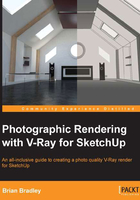
Looking at our SketchUp scene
To take a look at the first of the scene files that we will be working with throughout the duration of this book, you may want to load the Daylight_Interior_01.skp file from the Exercise_Files folder that has been provided as a downloadable resource.
This scene contains a small gallery type building that has been designed and created to give us both interior and exterior spaces in which we can work at creating lighting, materials, camera composition, and so on, as well as providing a number of challenges that we will need to overcome as we move forward with our project.
We have also, by design, only populated one of the interior rooms in this building, leaving you free to add your own set dressing to other areas, using them to do your own exploration and experimentation with the concepts and tools that we will discuss throughout this project.

Note
I would, at this point, encourage you to use every opportunity that you come across in this project to take the essence of what you learn in a particular chapter and then make use of it in any of the various versions of this scene that you have been supplied with. The more you experiment, the more sense the points we cover in this book will make.
Currently, all of the settings in the start scene are set to V-Ray defaults; in fact, the only work done so far has been the application of two V-Ray Standard materials to the scene geometry using RGB values of 88, 88, and 88 on the exterior material and 178, 178, and 178 for the interior version. These settings give us grayscale materials that have reflectance values of around 35 and 70 percent, respectively, which will be a big help to us as we set up our initial lighting for the scene.